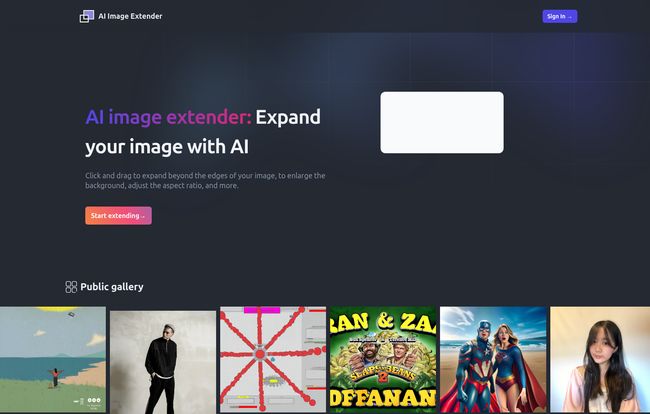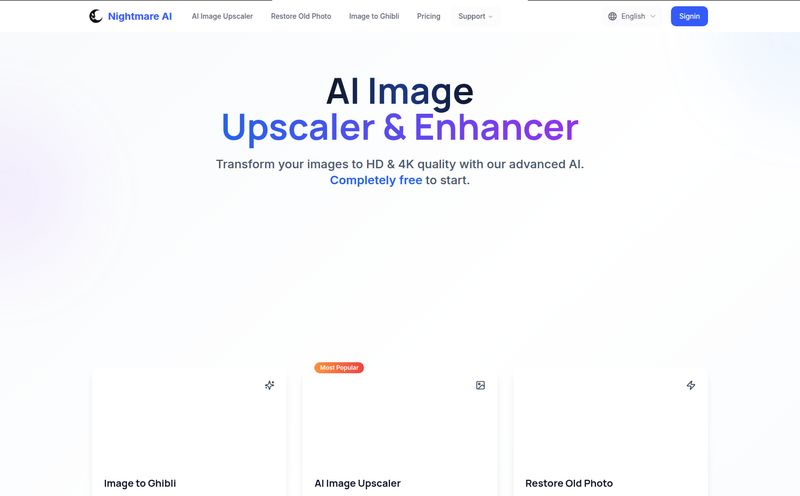You know the feeling. You've got the shot. The one that’s perfect for the blog post, the ad campaign, the 'gram. The lighting is chef's kiss, the subject is on point, everything is just… right. And then you try to upload it. Suddenly, you need it to be a 9:16 vertical for a Reel, a 2:1 horizontal for a Twitter header, and a 4:5 for the main feed. The perfect shot is now a composition nightmare.
We've all been there, hacking away in Canva or Photoshop, trying to clone stamp a bit of extra sky or desperately searching for a patch of grass that looks… kinda the same? It’s a frustrating, time-sucking vortex of creative despair. For years, the answer was either “live with the awkward crop” or “schedule a costly reshoot.”
But recently, a new wave of AI tools has started to offer a third option. They call it 'outpainting' or 'generative fill.' And today, I’m looking at one specific tool that’s popped up on my radar: the simply named AI Image Extender. The promise is simple: expand your image beyond its original borders. But does it actually work, or is it just another AI gimmick?
So, What is this AI Image Extender Anyway?
Think of it less as a photo editor and more as a digital canvas stretcher. The AI Image Extender is a tool designed to do one thing really well: take an existing image and intelligently create more of it. It looks at the content of your photo—the colors, the textures, the objects—and then generates new pixels around the edges to expand the scene. You can use it to turn a tightly-cropped portrait into a wider landscape, or change a horizontal photo into a vertical one by adding more information to the top and bottom.
This isn't about applying filters or adjusting brightness. This is about fundamentally changing the dimensions of your image while (hopefully) keeping it looking natural. It’s the kind of tech that feels like sci-fi, but is rapidly becoming a standard part of the content creator’s toolkit. It promises to fix those framing mistakes we all make, long after the photo has been taken.
The Click-and-Drag Dream: How It Actually Works
Okay, so how complicated is this? I've wrestled with my fair share of clunky software, and I have very little patience for a steep learning curve when I'm on a deadline. The good news? The AI Image Extender is ridiculously straightforward. The website says “click and drag,” and that’s… pretty much it.
You upload your image, and it appears in an editor. You then just grab the bounding box and pull it to the new aspect ratio or size you want. The tool shows you the new area that needs to be filled, you hit the 'extend' button, and the AI gets to work. Within moments, it presents you with the expanded version. No layers, no complicated toolbars, no masks. It’s designed for speed, and I have to admit, it delivers on that front. It's a far cry from the multi-step process in more traditional software.
The Good, The Bad, and The AI-Generated Ugly
No tool is perfect, right? Especially when you're letting an algorithm make creative decisions. Here's my honest breakdown after playing around with it.
The Good Stuff
The primary advantage here is the sheer amount of time and potential money saved. Instead of hiring a photographer for a reshoot because the initial images dont fit the new ad specs, you can potentially fix it in minutes. For social media managers, bloggers, and small businesses, this is huge. The ability to turn one solid image into assets for five different platforms without losing the core subject is a game-changer. It also does a surprisingly decent job of maintaining visual coherence. When expanding a background like a bookshelf or a sky, the textures and lighting often blend quite well. It’s not flawless, but it’s far better than what I could bash out with a clone stamp tool in the same amount of time.
Where It Stumbles (A Little)
Let's be real. AI can be… weird. The biggest caveat, which the platform itself seems to hint at, is that the extended results may not always meet expectations. If you're expanding a simple landscape or a textured background, it's pretty solid. But if you have complex subjects near the edge of the frame, you might get some… creative interpretations. A person's arm might get an extra elbow, or a pattern might not repeat quite right. You sometimes have to generate a few options to get one that works. It’s a bit of a creative lottery.
My other main gripe? There are no free credits. No free trial. You can't just test it out with one or two images to see if it works for your specific needs. You have to commit to a plan to even get started. In today's world of 'try before you buy' SaaS products, this feels like a bit of a miss. It suggests confidence in their product, maybe, but it’s a hurdle for people like me who want to kick the tires first.
Let's Talk Money: The Case of the Missing Pricing Page
Alright, so what's the damage? I clicked on their pricing link, ready to see the subscription tiers and credit packs… and was greeted by a 404 error. “Page not found: /pricing.”
Oops. Look, this happens. Websites break. But it does make it tough to give a full verdict. Based on the FAQ section which mentions subscriptions and purchasing additional subscriptions, I'm guessing it’s a monthly or annual plan. These types of AI tools usually operate on a credit system, where one image generation costs a certain number of credits. I would expect a few different tiers—perhaps a basic plan for casual users and a more robust one for agencies. For now, you’ll have to head to their homepage and see if they've fixed the link by the time you read this.
How Does It Stack Up Against the Goliaths?
The elephant in the room is, of course, Adobe. Photoshop's Generative Fill is incredibly powerful and integrated into a tool many of us already use. Canva also has its own version with Magic Expand. So why would you use a standalone tool like AI Image Extender?
The main argument is focus and simplicity. This tool is a scalpel, not a Swiss Army knife. If you don't need the full complexity of Photoshop and just want to quickly uncrop an image without getting lost in menus, this is a much faster workflow. It's built for one job, and it strips away everything else. For a social media manager who lives in a browser and not in the Adobe Creative Suite, this approach makes a ton of sense.
Final Thoughts: Is the AI Image Extender a Must-Have?
So, what’s my final take? The AI Image Extender is a genuinely useful tool that solves a very common, very annoying problem. It's fast, simple, and when it works well, it feels like magic. It can absolutely save you from creative dead-ends and the headache of mismatched aspect ratios.
However, the inconsistent results on complex images and teh lack of a free trial are definite drawbacks. It's not a magic wand that will fix every photo perfectly every single time. It's a powerful assistant, but one that still needs human supervision.
My verdict? If you constantly find yourself needing to repurpose images for different platforms, this tool could be a fantastic time-saver and a worthy investment. Just go in with realistic expectations and be prepared for the occasional AI-generated weirdness.
Frequently Asked Questions
How does the AI Image Extender work its magic?
It uses a trained artificial intelligence model. When you expand the canvas of your photo, the AI analyzes the existing pixels at the borders—the colors, patterns, and context—and then generates new pixels that it predicts should be there. It's essentially a very, very educated guess about what lies beyond the frame.
What if the AI gives me something... weird?
It happens! AI isn't perfect. If the generated extension looks strange (like adding a third leg to a dog), your best bet is to either slightly adjust the new frame and try generating again, or simply run the process again. Sometimes a second or third attempt can produce a much better result.
Why don't they offer a free trial or free credits?
That's the million-dollar question. While their site doesn't say, companies sometimes do this to avoid abuse from bots or to ensure that only serious users sign up. It’s a business decision, but one that can be frustrating for potential customers who want to test the service first.
Can I buy more credits if I'm on a subscription?
Based on one of the questions on their homepage (“I've already purchased a subscription, can I purchase additional subscriptions in the meantime?”), it seems they operate on a subscription model rather than a simple credit top-up system. You might need to buy another subscription or upgrade your plan, but this is speculative until their pricing page is back up.
What's the refund policy like?
The site's FAQ lists a question about refunds, but without access to the full policy, it's hard to say for sure. Generally, for digital services like this, refunds are often handled on a case-by-case basis, and many have a no-refund policy once credits or services have been used. Always check the terms of service before you buy.
Conclusion
The AI Image Extender is a sharp, focused tool in an increasingly crowded market of AI image generators. It's not trying to do everything; it's trying to solve the specific, nagging problem of image dimensions. It turns a tedious editing task into a quick, almost trivial one. While it's not without its quirks and the mysterious pricing is a bit of a head-scratcher, the core technology is solid. For content creators drowning in a sea of different social media specs, this could be the life raft you’ve been looking for.
Reference and Sources
- AI Image Extender Homepage: https://ai-image-extender.com/
- Adobe Photoshop Generative Fill: https://www.adobe.com/products/photoshop/generative-fill.html
- Canva Magic Expand: https://www.canva.com/magic-expand/




